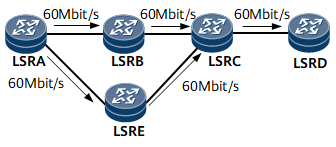Make-before-break
The make-before-break mechanism prevents traffic loss during a traffic switchover between two CR-LSPs. This mechanism improves MPLS TE tunnel reliability.
Background
The attributes, including bandwidth and path, of an established MPLS TE tunnel may change due to certain reasons. For example, a network administrator changes the bandwidth or explicit path of the tunnel according to service requirements, or a topological change on the network results in a better path. In this situation, a new CR-LSP needs to be established for the tunnel based on the new attributes, and traffic needs to be switched to the new CR-LSP. If the traffic is switched before the new CR-LSP is successfully established, traffic loss may occur. In this context, the make-before-break mechanism can be used to prevent traffic loss.
Make-before-break
Make-before-break is a mechanism that allows a CR-LSP to be established using changed bandwidth and path attributes over a new path before the original CR-LSP is torn down. It helps minimize data loss and additional bandwidth consumption. The new CR-LSP is called a modified CR-LSP. Make-before-break is implemented using the shared explicit (SE) resource reservation style.
The new CR-LSP competes with the original CR-LSP on some shared links for bandwidth. The new CR-LSP cannot be established if it fails the competition. The make-before-break mechanism allows the system to reserve bandwidth used by the original CR-LSP for the new CR-LSP, without calculating the bandwidth to be reserved. Additional bandwidth is used if links on the new path do not overlap the links on the original path.
Assume that the maximum reservable bandwidth of all links is 60 Mbit/s as shown in Figure 1. A CR-LSP along the path LSRA → LSRB → LSRC → LSRD is established, with the bandwidth of 40 Mbit/s.
The path is expected to change to LSRA → LSRE → LSRC → LSRD to forward data because LSRE has a light load. However, the reservable bandwidth of the link between LSRC and LSRD is just 20 Mbit/s, not enough for establishing the LSP. The make-before-break mechanism can be used in this situation.
The make-before-break mechanism allows the newly established CR-LSP over the path LSRA → LSRE → LSRC → LSRD to use the bandwidth of the original CR-LSP's link between LSRC and LSRD. After the new CR-LSP is established over the path, traffic switches to the new CR-LSP, and the original CR-LSP is torn down.
In addition to the preceding method, another method of increasing the tunnel bandwidth can be used. If the reservable bandwidth of a shared link increases to a certain extent, a new CR-LSP can be established.
Assume that the maximum reservable bandwidth of all links is 60 Mbit/s as shown in Figure 1. A CR-LSP along the path LSRA → LSRB → LSRC → LSRD is established, with the bandwidth of 30 Mbit/s.
The path is expected to change to LSRA → LSRE → LSRC → LSRD to forward data because LSRE has a light load, and the bandwidth is expected to increase to 40 Mbit/s. The reservable bandwidth of the link between LSRC and LSRD is just 30 Mbit/s. The total available bandwidth for the new path is less than 40 Mbit/s. The make-before-break mechanism can be used in this situation.
The make-before-break mechanism allows the newly established CR-LSP over the path LSRA → LSRE → LSRC → LSRD to use the bandwidth of the original CR-LSP's link between LSRC and LSRD. The bandwidth of the new CR-LSP is 40 Mbit/s, out of which 30 Mbit/s is released by the link between LSRC and LSRD. After the new CR-LSP is established, traffic switches to the new CR-LSP and the original CR-LSP is torn down.
Delayed Switchover and Deletion
In real-world applications, the service status of each node on an MPLS network varies. If an upstream node on an MPLS network is busy but its downstream node is idle or an upstream node is idle but its downstream node is busy, a CR-LSP may be torn down before the new CR-LSP is established, causing a temporary traffic interruption.
To prevent this temporary traffic interruption, the switching and deletion delays are used together with the make-before-break mechanism. In this case, traffic switches to a new CR-LSP a specified delay time later after a new CR-LSP is established. The original CR-LSP is torn down a specified delay later after a new CR-LSP is established. The switching delay and deletion delay can be manually configured.
